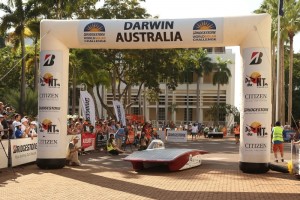
The Stanford Solar Car Project (SSCP) finished in sixth place in the World Solar Car Challenge in Australia, a biennial international race with over 40 teams from around the world. SSCP is a completely student-run organization on campus that specializes in solar-powered cars. The team has been designing and building their car, Arctan, for the past year and a half.
Preparing for the race
The team has been working on the car since last June, when the rules for the competition were released. They focused on reliability this year to ensure that the car would finish the race. Changes to this year’s car include moving the driver’s seat between the front and rear tires on the right side.
The team arrived in Australia a month prior to the race to assemble the shipped car and prepare for the race. They ran through the entire race in order to train the team to be as efficient as possible.
“In the Outback, once something happens, you can’t really ask for help.” said Darren Chen ’15 M.S. ’16, an engineering lead on the team. “You’re in the middle of a desert, so you don’t have access to a machine shop or special tools. Anything that could possibly go wrong we have to be prepared for. If something is to go wrong, you have to figure it out yourself.”
The race itself took place in the Australian Outback on flat, straight land. There are few turns in the entire race. Arctan finished the 3022 km race in 41 hours, 23 minutes and 59 seconds.
“The team ran a tight ship the entire race, not stopping once except for control stops and end of race day. SSCP performed so well because of the extensive testing, incredible determination and focus of the race crew and drivers, and support of the parents,” wrote Alex Lubkin ’17 on the team’s blog.
After the race, SSCP followed tradition and gathered with the other teams from around the world for a party and then packed the car up to be shipped back to Stanford. The team will spend the rest of their leave of absence for fall quarter traveling around Australia and the neighboring region.
Looking forward
This year, the team ran a smooth race and finished in sixth place, their second best in recent history. In 2013, the team finished in fourth at the competition.
However, the team is slowly catching up to the top teams from the Delft University of Technology and the University of Twente in the Netherlands. In 2011, SSCP did not finish the race, and in 2013, they were about four hours behind the winning car. This year, SSCP was less than three and a half hours behind the winning car from the Nuon Solar Team from the Netherlands.
The next steps include improvements to the car’s structure.
“The two parts are better aerodynamics for consuming less power – to really sip on power – and also getting better solar panels in order to make a ton of power. Both get more power and use less of it – that’s what makes a fast car,” Chen said.
On campus, SSCP has been training new members to prepare for the next race, which will occur in 2017.
“I’ve been running recruitment, and other people and I have been taking new members and training them to use machines, and get comfortable with other aspects of the car, such as solar cells, codes, electronics,” said Reed Kraus ’18. “We’re just really big with new member orientation right now to get people up to speed to design the next car.”
The ability to be part of a unique group continues to draw freshmen and new members every year.
“It’s crazy that you can actually have students building and designing a car like this,” said Greg Brandao Lopes ’18. “You don’t have to come in knowing how to build a car or design it. I had no experience and they started giving me things to do. It’s a really cool project.”
Contact Anne-Marie Hwang at amhwang ‘at’ stanford.edu.
